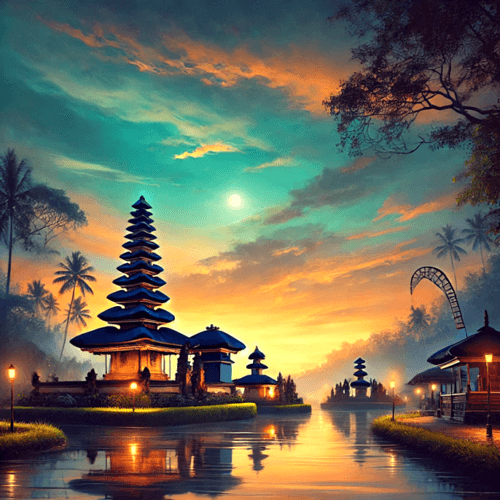Brahma, Vishnu, Shiva, and Krishna: The Hindu Pantheon of Creation, Preservation, Destruction, and Love
Hinduism offers a rich tapestry of gods and goddesses, each representing aspects of existence, cosmic functions, and human experiences. Among them, Brahma, Vishnu, and Shiva form the Trimurti, representing creation, preservation, and destruction, respectively. In addition to these three, Krishna, an incarnation of Vishnu, holds a unique place in Hindu worship, embodying divine love, wisdom, and playfulness. Let’s explore the roles and significance of these deities and their interconnections.
Brahma – The Creator
Brahma is the god of creation, responsible for generating the universe and everything within it. He is often depicted with four heads, symbolizing omnipresence and wisdom. Although he plays a foundational role in Hindu cosmology, Brahma is worshiped less frequently than Vishnu and Shiva, which is attributed to myths that describe his pride and a resulting curse.
His consort Saraswati, the goddess of wisdom, plays a crucial role in inspiring his creative powers. Together, they represent the unity of knowledge and creation.
Vishnu – The Preserver
Vishnu is the cosmic protector, responsible for maintaining order and balance in the universe. Whenever evil forces threaten the natural harmony, Vishnu descends to earth in different forms, known as avatars, to restore righteousness. Among his ten most significant avatars (Dashavatara), Krishna and Rama are the most widely worshiped.
Vishnu is typically depicted with four arms, holding a conch shell, discus, mace, and lotus, signifying his protective and nurturing nature. His divine consort, Lakshmi, symbolizes prosperity, further emphasizing his role in ensuring the wellbeing of the universe.
Shiva – The Destroyer
Shiva’s role as the destroyer is not purely destructive but transformative. His function is to clear the path for new creation by ending stagnation and old cycles. Often seen in meditation or performing the Tandava (cosmic dance), Shiva symbolizes the rhythmic balance of life’s beginnings and endings.
Attributes such as his third eye (insight), trident (control over cosmic forces), and snake around his neck (mastery over desires) reflect his spiritual power. With his consort Parvati and their son Ganesha, Shiva represents a harmonious family dynamic within divine chaos.
Krishna – The Divine Lover, Teacher, and Avatar of Vishnu
Krishna is one of the most revered and beloved figures in Hindu mythology, known for his complex personality and profound teachings. As the eighth avatar of Vishnu, Krishna appears in different roles—each revealing aspects of divinity and human nature. His life is narrated in sacred texts such as the Mahabharata, Bhagavad Gita, and Bhagavata Purana.
The Birth and Childhood of Krishna
Born to Devaki and Vasudeva in a prison cell under the tyrannical rule of King Kamsa, Krishna’s arrival was surrounded by danger. To protect the divine child, Vasudeva secretly carried Krishna across the Yamuna River to Gokul, where he was raised by the cowherds Yashoda and Nanda.
As a child, Krishna was known for his playful and mischievous nature. One of the most popular stories from his childhood describes him as the Makhan Chor (butter thief), stealing butter from homes and charming the villagers with his antics. These playful actions highlight the joy, innocence, and spontaneity of divine love.
Krishna as a Lover in Vrindavan
As he grew older, Krishna became known for his enchanting flute music, which mesmerized the people of Vrindavan, especially the Gopis (milkmaids). His relationship with Radha, the foremost among the Gopis, symbolizes the highest form of divine love, where the soul seeks union with the divine. Krishna’s youthful interactions in Vrindavan embody bhakti (devotion), teaching that love for God transcends worldly boundaries.
Krishna as the Teacher in the Mahabharata
Krishna’s role as a guide and teacher is most prominently seen in the Bhagavad Gita, a part of the Mahabharata. In the epic, Krishna serves as the charioteer for the warrior Arjuna on the battlefield of Kurukshetra. When Arjuna is overcome by doubt and moral confusion, Krishna imparts the profound teachings of the Gita, emphasizing:
- Karma Yoga – The importance of selfless action
- Bhakti Yoga – Devotion to God as a path to liberation
- Jnana Yoga – The pursuit of knowledge and wisdom
Krishna’s teachings encourage individuals to live virtuously, act without attachment to outcomes, and realize their oneness with the divine.
The Interconnectedness of the Trimurti and Krishna
Although Krishna is an avatar of Vishnu, his teachings and stories complement the functions of Brahma, Vishnu, and Shiva. His playful childhood reflects the joy of creation associated with Brahma. As a preserver of dharma (righteousness) and order, Krishna fulfills Vishnu’s mission to maintain cosmic harmony. Additionally, Krishna’s guidance in the Bhagavad Gita aligns with Shiva’s transformative power, as he teaches Arjuna to transcend fear and embrace change.
Together, Brahma, Vishnu, Shiva, and Krishna represent a complete picture of existence—creation, preservation, transformation, and devotion—illustrating the cyclical and harmonious nature of life.
Conclusion
Brahma, Vishnu, Shiva, and Krishna play pivotal roles in Hindu philosophy, offering profound insights into the nature of existence and spiritual growth. Brahma’s creation, Vishnu’s preservation, and Shiva’s destruction reflect the cycle of life and the universe. Krishna, as the divine lover, teacher, and avatar, adds a deeply personal dimension to this cosmic framework. His life and teachings inspire love, devotion, and wisdom, showing the way toward self-realization and inner peace.
Through the worship of these deities, Hindus embrace not only the cycle of life but also the idea that love, wisdom, and transformation are integral to spiritual fulfillment.






